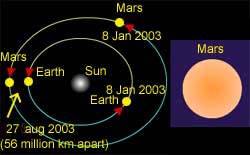
Dimdima
Online Children's Magazine from India

Dimdima
Online Children's Magazine from India

Thousands of stargazers stayed up all night to view the red planet on 27 August this year. For the first time in more than 60, 000 years Mars and Earth passed closest to each other. And they will not come so close again for another 60, 000 years, say scientists. The two planets were 56 million kilometres (35 million miles) apart - as close as they can ever get to each other.
Visible as a bright red object, Mars outshone all other planets that night, seen with such clarity to the naked eye. Telescopes recorded the finer details.
Mars has been of interest to us, as there has been speculation for a long time that Mars supports life. It is believed that probably tiny single celled life may have, or may still be surviving beneath the surface on Mars. There is a debate on presence of water on Mars, which could support life forms. Mars has the biggest volcano in the Solar System, the now inactive 26-km-high Olympus Mons
The United States and Russia have spent billions to land space probes on Mars to enable study of the planet. Only three have been successful so far - The US Viking landed in 1976 and its Mars Pathfinder in 1997.
A new search for water and life on Mars has begun this year, with Europe's first solo mission to Mars and the launch of US Mars Exploration Rovers. The first Japanese Mars orbiter, Nozomi, will also reach Mars after a four-and-a-half-year voyage from Earth.
EXPLORE MORE...
Get Help or Give Help.
- Do you have a Science Question?
- Post it here and get the answer.
- Some questions posted by others are not yet answered.
- View those questions and answer them.
Dimdima is the Sanskrit word for ‘drumbeat’. In olden days, victory in battle was heralded by the beat of drums or any important news to be conveyed to the people used to be accompanied with drumbeats.
Bharatiya Vidya Bhavan
K. M Munshi Marg,
Chowpatty, Mumbai - 400 007
email : editor@dimdima.com
Bharatiya Vidya Bhavan
505, Sane Guruji Marg,
Tardeo, Mumbai - 400 034
email : promo@dimdima.com
Dimdima.com, the Children's Website of Bharatiya Vidya Bhavan launched in 2000 and came out with a Printed version of Dimdima Magazine in 2004. At present the Printed Version have more than 35,000 subscribers from India and Abroad.